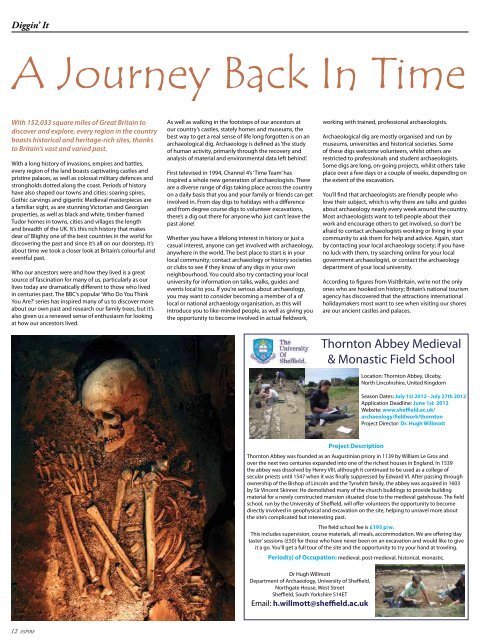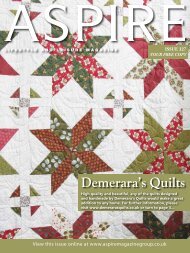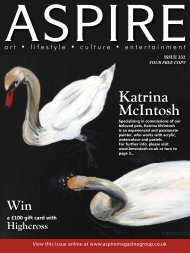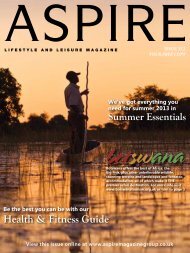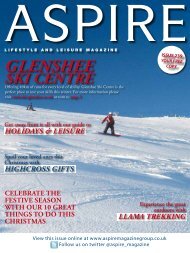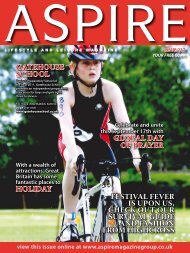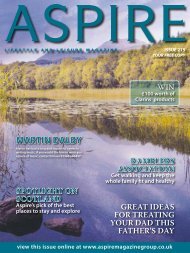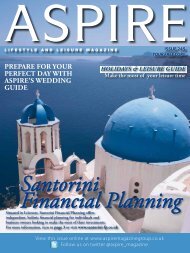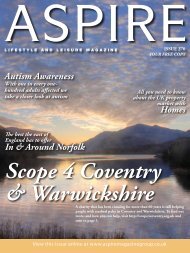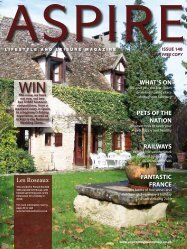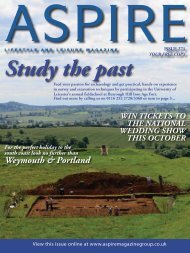Bosworth Court Care Home - Aspire Magazine
Bosworth Court Care Home - Aspire Magazine
Bosworth Court Care Home - Aspire Magazine
You also want an ePaper? Increase the reach of your titles
YUMPU automatically turns print PDFs into web optimized ePapers that Google loves.
Diggin’ It<br />
For information on <strong>Bosworth</strong> <strong>Court</strong> <strong>Care</strong> <strong>Home</strong><br />
Call 01455 290867<br />
or email bosworthcourt@givecare.co.uk<br />
A Journey Back In Time<br />
With 152,033 square miles of Great Britain to<br />
discover and explore, every region in the country<br />
boasts historical and heritage-rich sites, thanks<br />
to Britain’s vast and varied past.<br />
With a long history of invasions, empires and battles,<br />
every region of the land boasts captivating castles and<br />
pristine palaces, as well as colossal military defences and<br />
strongholds dotted along the coast. Periods of history<br />
have also shaped our towns and cities; soaring spires,<br />
Gothic carvings and gigantic Medieval masterpieces are<br />
a familiar sight, as are stunning Victorian and Georgian<br />
properties, as well as black and white, timber-framed<br />
Tudor homes in towns, cities and villages the length<br />
and breadth of the UK. It’s this rich history that makes<br />
dear ol’ Blighty one of the best countries in the world for<br />
discovering the past and since it’s all on our doorstep, it’s<br />
about time we took a closer look at Britain’s colourful and<br />
eventful past.<br />
Who our ancestors were and how they lived is a great<br />
source of fascination for many of us, particularly as our<br />
lives today are dramatically different to those who lived<br />
in centuries past. The BBC’s popular ‘Who Do You Think<br />
You Are?’ series has inspired many of us to discover more<br />
about our own past and research our family trees, but it’s<br />
also given us a renewed sense of enthusiasm for looking<br />
at how our ancestors lived.<br />
As well as walking in the footsteps of our ancestors at<br />
our country’s castles, stately homes and museums, the<br />
best way to get a real sense of life long forgotten is on an<br />
archaeological dig. Archaeology is defined as ‘the study<br />
of human activity, primarily through the recovery and<br />
analysis of material and environmental data left behind’.<br />
First televised in 1994, Channel 4’s ‘Time Team’ has<br />
inspired a whole new generation of archaeologists. There<br />
are a diverse range of digs taking place across the country<br />
on a daily basis that you and your family or friends can get<br />
involved in. From day digs to holidays with a difference<br />
and from degree course digs to volunteer excavations,<br />
there’s a dig out there for anyone who just can’t leave the<br />
past alone!<br />
Whether you have a lifelong interest in history or just a<br />
casual interest, anyone can get involved with archaeology,<br />
anywhere in the world. The best place to start is in your<br />
local community; contact archaeology or history societies<br />
or clubs to see if they know of any digs in your own<br />
neighbourhood. You could also try contacting your local<br />
university for information on talks, walks, guides and<br />
events local to you. If you’re serious about archaeology,<br />
you may want to consider becoming a member of a of<br />
local or national archaeology organisation, as this will<br />
introduce you to like-minded people, as well as giving you<br />
the opportunity to become involved in actual fieldwork,<br />
Thornton Abbey Medieval<br />
& Monastic Field School<br />
Project Description<br />
Location: Thornton Abbey, Ulceby,<br />
North Lincolnshire, United Kingdom<br />
Season Dates: July 1st 2012 - July 27th 2012<br />
Application Deadline: June 1st 2012<br />
Website: www.sheffield.ac.uk/<br />
archaeology/fieldwork/thornton<br />
Project Director: Dr. Hugh Willmott<br />
Thornton Abbey was founded as an Augustinian priory in 1139 by William Le Gros and<br />
over the next two centuries expanded into one of the richest houses in England. In 1539<br />
the abbey was dissolved by Henry VIII, although it continued to be used as a college of<br />
secular priests until 1547 when it was finally suppressed by Edward VI. After passing through<br />
ownership of the Bishop of Lincoln and the Tyrwhitt family, the abbey was acquired in 1603<br />
by Sir Vincent Skinner. He demolished many of the church buildings to provide building<br />
material for a newly constructed mansion situated close to the medieval gatehouse. The field<br />
school, run by the University of Sheffield, will offer volunteers the opportunity to become<br />
directly involved in geophysical and excavation on the site, helping to unravel more about<br />
the site’s complicated but interesting past.<br />
The field school fee is £195 p/w.<br />
This includes supervision, course materials, all meals, accommodation. We are offering ‘day<br />
taster’ sessions (£50) for those who have never been on an excavation and would like to give<br />
it a go. You’ll get a full tour of the site and the opportunity to try your hand at trowling.<br />
Period(s) of Occupation: medieval, post-medieval, historical, monastic.<br />
Dr Hugh Willmott<br />
Department of Archaeology, University of Sheffield,<br />
Northgate House, West Street<br />
Sheffield, South Yorkshire S14ET<br />
Email: h.willmott@sheffield.ac.uk<br />
working with trained, professional archaeologists.<br />
Archaeological dig are mostly organised and run by<br />
museums, universities and historical societies. Some<br />
of these digs welcome volunteers, whilst others are<br />
restricted to professionals and student archaeologists.<br />
Some digs are long, on-going projects, whilst others take<br />
place over a few days or a couple of weeks, depending on<br />
the extent of the excavation.<br />
You’ll find that archaeologists are friendly people who<br />
love their subject, which is why there are talks and guides<br />
about archaeology nearly every week around the country.<br />
Most archaeologists want to tell people about their<br />
work and encourage others to get involved, so don’t be<br />
afraid to contact archaeologists working or living in your<br />
community to ask them for help and advice. Again, start<br />
by contacting your local archaeology society; if you have<br />
no luck with them, try searching online for your local<br />
government archaeologist, or contact the archaeology<br />
department of your local university.<br />
According to figures from VisitBritain, we’re not the only<br />
ones who are hooked on history; Britain’s national tourism<br />
agency has discovered that the attractions international<br />
holidaymakers most want to see when visiting our shores<br />
are our ancient castles and palaces.<br />
Exciting year for<br />
Piddington Roman Villa Museum<br />
Fine pottery from the continent, glassware,<br />
manicure sets and even oyster shells are just a<br />
few of the ancient Roman artefacts unearthed at<br />
the Piddington Roman Villa in the past 33 years,<br />
at a site occupied from 50BC until the early Fifth<br />
Century.<br />
The Heritage Lottery funded Piddington Roman Villa<br />
Museum, directed by Roy and Liz Friendship-Taylor,<br />
exhibits the historical items discovered at the site<br />
through excavations over the past three decades. The<br />
excavation, which is still on-going today, is conducted<br />
by the Upper Nene Archaeological Society, which is<br />
celebrating its 50th anniversary this year.<br />
The Museum is holding two special events: a Roman<br />
Family Day, on Saturday, 7th July, and an Open Day<br />
on Saturday, 25th August, both 11am – 4:30pm.<br />
Members of the public attending the Family Day will<br />
be able to take part in a range of activities – from<br />
learning about Roman cooking, meeting Roman reenactors<br />
and marvelling at the various artefacts that<br />
detail Roman life.<br />
Liz, who has a long held interest in history, said:<br />
“I have been passionate about history for a long<br />
time; my father was a Latin teacher so I grew up<br />
learning about history before studying History and<br />
Archaeology at university. The site was re-discovered<br />
during farming and the museum was founded in the<br />
disused Wesleyan Chapel in Piddington, after we had<br />
been digging for some years.”<br />
The museum has built close relationships with<br />
schools in Northamptonshire, Peterborough and<br />
Cambridgeshire. School children visit the museum<br />
and are able to dig on the site and enjoy hands-on<br />
activities, such as learning about Roman cooking their<br />
dress, their medicines, writing, farm animals and how<br />
they built their houses. Visits last either half a day or a<br />
whole day.<br />
The excavation at the site is carried out on Sundays,<br />
from Easter to October, as well as a week at Easter<br />
and all of August. The museum is open from 2pm to<br />
5pm on Sunday afternoons; however, due to their<br />
close living proximity to the Museum, Liz and Roy<br />
are happy to arrange other times by appointment.<br />
The admission cost is £3.50 for adults and £2 for<br />
concessions, including children, retired people, village<br />
residents and groups.<br />
Fascinating displays at the museum bring Roman<br />
times to life and detail how it may have been to<br />
be alive as far back as 50BC and it also houses a<br />
study and library. For those who would like to get<br />
involved and perhaps unearth a Roman gem or two<br />
themselves, the museum welcomes volunteers for<br />
excavations and also for various activities at the<br />
Museum.<br />
For further information<br />
please contact Liz on 07752 429911,<br />
email piddington.museum@tiscali.co.uk<br />
or visit www.unas.org.uk<br />
12 ASPIRE<br />
ASPIRE 13


